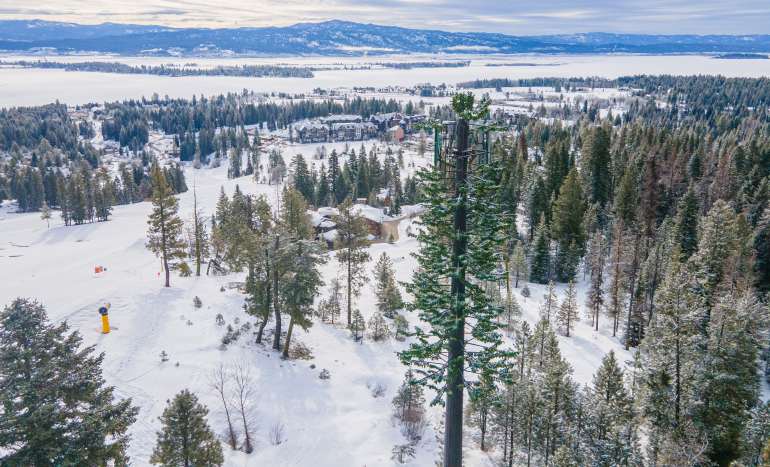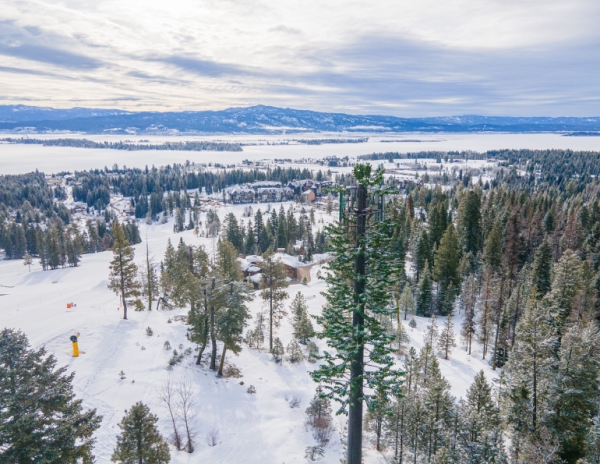At ski areas, cellular and Wi-Fi connectivity is becoming as important as the chairlifts and snowmaking systems that draw skiers and riders to the hill. But in the rural, mountainous areas that lend themselves to the development of ski areas, staying connected can be a challenge.
In the last two decades, smartphones have infiltrated our lives both on- and off-mountain. According to a survey conducted by the Pew Research Center in 2023, 90 percent of Americans own a smartphone—a number that rises to 98 percent for those earning $100,000 or more, i.e., typical resort guests.
This is no more evident than on busy vacation weekends, when ski area base lodges are filled with children and teens with their heads buried in their devices—the electronic babysitters of the 2020s—while parents take a few minutes to enjoy a beer and talk about their day on the slopes.
But the importance of smartphone connectivity at ski areas extends far beyond kids’ ability to check TikTok and keep up with the latest memes. It affects both the guest experience and the ski area’s ability to reach potential guests.
“If you have terrible connectivity, you are losing a tremendous amount of impressions from guests who want to get the word out that they’re having the time of their lives,” says Ben Wilcox, general manager of New Hampshire’s Cranmore Mountain Resort. “In the old days, you’d see a newspaper ad or billboard, but today, [marketing is] about giving your guests connectivity.”
The Infrastructure
Cranmore has struggled with both cellular and Wi-Fi connectivity during the last four to five years, especially on peak days. That struggle became more urgent after the resort released an app during the 2023-24 ski season that allows guests to interact and keep up to date on mountain conditions, closures, and various happenings. Cranmore’s connectivity challenges sometimes hinder a guest’s ability to take advantage of the new technology. That’s also true for many other ski areas that are now leaning on apps to enhance the guest experience.
Add in the need for mountains to digitally publish daily snow reports and conditions updates, upload media assets, maintain webstore servers and so on, and ensuring fast and reliable cellular and Wi-Fi connectivity becomes a necessity.
Wi-Fi connectivity. In recent years, Cranmore has put more of a focus on its Wi-Fi connectivity than cellular, leaving cellular capital investments and improvements up to the providers that lease land at the ski area’s summit. The infrastructure at the summit provides cellular service not just to Cranmore, but to the entire town of North Conway.
Amidst a $60 million base area redevelopment project, the resort has taken steps to improve Wi-Fi connectivity, including upgrading to a high-speed fiber connection, upgrading access points around the resort, and adding an opt-in option to the public Wi-Fi to minimize the number of devices connecting automatically in the background.
“The main challenge to this process is cost and the time it takes to upgrade our network in a cost-effective and secure way,” says Becca Deschenes, Cranmore director of marketing. The costs of the Wi-Fi upgrade are planned for as part of the resort’s overall information technology (IT) budget and not easily separated out, says Deschenes, who adds that part of the planning process means finding a balance in the budget “between operations and services, groomer and lift repairs, and Wi-Fi connectivity.”
Cellular connectivity. Of course, Wi-Fi connectivity at a ski area can only get you so far. On the slopes, cellular connectivity is required for guests to listen to music, post to social media, and make a call should an emergency arise.
In Idaho, Tamarack Resort is working with Horvath Communications, a telecommunications infrastructure company that owns and manages wireless assets, to improve cellular connectivity on the mountain and in the base village.
According to Tamarack president Scott Turlington, Horvath was the driver behind the project. The company identified Tamarack as a profitable place to expand cellular connectivity and, around two years ago, reached out to the ski area about installing a cell tower on Tamarack’s state-leased land. Once those wheels were set in motion, says Turlington, Horvath began working to secure leases with the cellular providers.
There are typically several factors that make a site appealing to cellular providers and thus third-party companies as well, namely a sufficient number of cellular users and whether other carriers are already offering service in the area (meaning that offering your service in the area as well is necessary to remain competitive).
In addition to the cell tower, Horvath also installed a network of distributed antennae systems (DAS) around the base area of the resort. DAS—of which there are several types and configurations—are typically used in indoor spaces where demand for cellular connectivity is high, and the building itself prevents a signal from being usable due to things like building materials or distance from a tower.
“In these newer buildings we’ve constructed, the [cellular] signals are diminished, and not everyone wants to use Wi-Fi calling,” says Turlington. “So, the interior of our buildings now all have capabilities that allow [mobile phones] to operate just as if they’re outside.”
While a DAS is typically best for indoor uses, it can also be implemented outdoors in areas with rough terrain where erecting a tower might not be feasible. A DAS connects a signal source to a group of antennae, allowing for the distribution of wireless signal coverage to areas that are otherwise difficult to service.
Both cellular tower and DAS solutions require some time to implement. Constructing a tower can sometimes take more than a year due to permitting and construction. Implementing DAS can sometimes take longer, especially if a tower must first be constructed to be used as the signal source.
Cost and Required Resources
For Tamarack, the cost and resources required for these upgrades have been minimal. And the resort will actually receive a small portion of the revenue generated by the towers.
“There’s really no cost for us when it comes to a cell tower. The cost is really up to Horvath, and then they’ll make all of the arrangements,” says Turlington. “It’s a great opportunity for us to increase our capabilities here and provide additional service without having to come out of pocket.”
Tamarack did have to invest some resources during the beginning of the process, connecting Horvath with the state and helping them determine the best place for the tower to be built. Otherwise, it’s been up to Horvath to run with the project.
Different situations. But this scenario might not be the case for every ski area. Like Tamarack, ski areas will often work with a third-party company that in turn secures carriers to join the system. But while it was once common for carriers to pay for coverage, increasingly, carriers require someone else to cover at least some of the costs before committing to providing service. Sometimes, this cost falls on the ski area.
“It all depends on the whole economic return on investment for that particular ski area,” says Jon Diack, the director of business development for NeuComm Solutions, another third-party entity that works with providers, property owners and municipalities to expand cellular connectivity. “[Some] ski areas are open only for four months. Carriers might not want to spend millions of dollars anymore like they used to.”
 A new cell tower is part of a connectivity upgrade at Tamarack Resort in Idaho.
A new cell tower is part of a connectivity upgrade at Tamarack Resort in Idaho.
Depending on the venue, existing infrastructure, and technology utilized, pricing for the installation of cellular connectivity infrastructure can vary greatly. But according to Ken Schmidt, president of Steel In The Air, Inc., which specializes in helping companies negotiate cell tower leases and valuate the towers themselves, $1 to $2 per square foot is a good starting point for indoor DAS systems. An outdoor DAS system typically costs $50,000 to $100,000 per node, and a cellular tower starts around $450,000. How effective a single outdoor DAS node will be is highly dependent on the technology used, how and where it’s mounted, how heavy usage is, and how obstructed the area is.
NeuComm, which is currently working with a few ski areas, typically builds the required infrastructure and works to get carriers to transmit their signals there. The company charges the cost of construction, with a slight markup.
Who picks up that cost is dependent on the ski area’s size and how much of a return on investment the carriers anticipate. “The partnership between the three entities may be such that the carriers might say, ‘You’re not a big enough ski area for me to cough up dollars to build infrastructure,’” says Diack. “‘But if you provide us a tower and a building, we’ll come in and we’ll rent space to put our antennas and radios in there. But we’re not going to pay a one-time fee for all the infrastructure.’”
At larger ski areas with high visitation, carriers may be more willing to make more of a financial investment to be on the mountain.
To complicate things further, ski areas can also opt to build their own infrastructure and rent the space out to the carriers. This tends to be the quickest way to get upgrades going for those with the capital to cover the upfront costs. Some ski areas charge the carriers a percentage of construction costs and an additional monthly fee to cover rent and maintenance. These details are typically worked out between the third-party communications company, ski area, and carriers, and are dependent on what the carriers think the return on their investment will be, which is correlated with the number of people using their smartphones on the mountain.
Sustainable Solutions?
As connectivity becomes increasingly important, new technology that lends itself to more sustainable operation is becoming more commonplace. In the past, each carrier needed its own dedicated equipment to provide service. Today, technologies like Private LTE/5G or multi-operator radio access networks (MORAN) allow for use of a limited set of radio equipment suitable for all major carriers.
These single solutions that are suitable to multiple carriers are less invasive, cheaper, and easier to build, according to Diack. Additionally, “[these technologies] limit your power requirements, which means you can power it from alternative sources, like solar, a lot easier,” he says. “Power requirements can sometimes be only a third of traditional carrier needs.”
So far, not many American carriers have adopted these technologies because they require a different type of infrastructure than the more prevalent single-carrier connectivity solutions. The question, says Schmidt, is no longer whether or not all carriers can utilize these technologies but, rather, will they?
“Verizon, for example, has pretty much avoided connecting to private networks at smaller and midsize venues. So, while a ski resort can add a private network, it doesn’t mean that Verizon’s service will be accessible through it,” he explains.
To see widespread implementation of more sustainable connectivity technology at ski areas, Diack feels larger ski areas must adopt it first. According to Diack, smaller ski areas don’t have the leverage to tell providers what kind of technology they need to use in order to be on their mountain, whereas larger ski areas, like those owned by multi-resort ownership groups, do.
If a larger, busy ski area that a carrier sees as a profitable location requires the carrier to adopt a more sustainable solution, then, in theory, the carrier will have no other choice if it wants to be on that specific mountain.
Diack believes that kind of pressure would be good not just for the ski industry, but for the entire telecommunications infrastructure industry. “Maybe the ski areas are the ones that show carriers that this can be done not just at ski areas, but all over,” he says.






